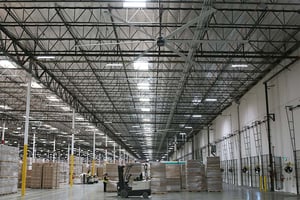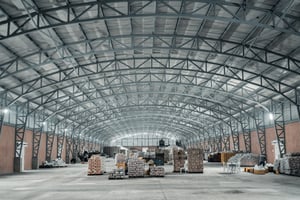Warehouses and logistics facilities generally encompass massive square footage. They are filled...
Warehouse Cooling - 5 Tips You Need to Know
Warehouses are an important element of the modern economy. For building managers and engineers, warehouse cooling can pose serious HVAC challenges. This is due to their size and unique design. Due to this, energy and warehouse cooling costs can get out of hand if not paid attention to. So, what are the common warehouse cooling problems that frequently occur? And what are the best warehouse cooling tips and tricks to know that won't break the bank? In this blog, we will answer those two questions. You will leave feeling confident in how to keep your warehouse energy costs down, your facility cool, and your employees comfortable.
1. Strive for an ideal temperatures range
Human comfort and safety should be the number one concern for facility managers responsible for warehouses with a workforce of people inside of them. According to OSHA, thousands of employees in the United States fall victim to heat-related ailments every year, even though these issues are preventable.
According to OSHA, ideal temperature control should be in the range of 68°F-76°F, and humidity control should be in the range of 20%-60%. This ideal temperature range will create the most comfortable environment for employees and will promote the most productivity. In fact, one Cornell study found that employees were more accurate when temperatures were in that ideal range. The study also found that employers saved an average of $2 per hour, per worker when temperature levels were within the range.
Workers and managers should be aware of the repercussions of excessive heat. It is important to be aware of the signs of heat-related illnesses. In addition, they need to be prepared for elevated heat levels and know how to deal with them. Paying attention to building temperatures helps employers plan rest schedules and calculate work rates when employees are working in hot environments.
If employees begin to experience heat illness, they should take a break. They also should drink cool water and rest. Further, encourage employees to watch out for each other and ask one another if they are doing okay.
2. Close it up!
Most warehouses need to accept deliveries or send out shipments multiple times a day, which exposes the warehouse to the outdoor climate. This problem is compounded by the large size of open bays, which means they allow more air to escape than a normal door while open.
One way to combat this issue is to keep your building bays and doors closed as often as possible during hot weather. Also, make sure your space is airtight and insulated well. Every chance you get to keep that cool air inside is better than letting it escape. As any father has once said, “Shut the door! What? Do you think we are air conditioning the outside?!”
3. Add HVLS fans to de-stratify the layers of air
We know it is bound to happen. Hot air will creep into your warehouse. So, you must create a more even distribution of air inside. When the air temperature is more evenly distributed throughout the space, it means the temperature inside of the warehouse is affected less by doors opening and closing.
A warehouse is a HUGE space. Where residential and commercial office buildings usually have ceilings of around 8' to 12', an average warehouse could have ceilings as high as 20' or 30'. As the day progresses, the air in a warehouse continues to heat up, which raises the temperature.
To solve this problem you need a method of moving high volumes of air to de-stratify the thermal layers that occur as a result of heat building up at the high ceilings. This helps distribute cool air throughout the entire building to keep the temperature cooler everywhere.
The best solution to getting that air de-stratified is by adding HVLS ceiling fans. These are not your regular, average-sized ceiling fans. High Volume Low Speed (HVLS) ceiling fans range in size from 6-24 feet in diameter. Think about that! HUGE! By adding one of these massive fans you can reduce temps by up to 8°F in your warehouse by moving air from the ceiling to floor and from wall to wall. Plus, these fans are perfect for very large spaces. In fact, one HVLS fan can affect up to 20,000 square feet of space. On top of the size, they are extremely energy efficient, saving you up to 30% in your energy costs.
4. Properly ventilate your warehouse
Because of the large space and air distribution challenges of warehouses, hot air tends to stagnate throughout the building. Additionally, many warehouses serve as manufacturing or processing centers where employees use chemicals that get mixed into hot air.
These circumstances lead to a reduced quality of air throughout the warehouse. If left unchecked, this reduction in air quality can lead to serious problems including sick building syndrome (SBS). This condition causes coughing, dizziness, irritation, and discomfort for occupants of the building. The Environmental Protection Agency (EPA) has estimated that up to 30% of new and remodeled buildings could suffer from SBS.
To solve indoor air quality (IAQ) problems within your warehouse, the EPA advises that you have proper ventilation and air distribution systems in place. You should also be sure that you follow all applicable OSHA air quality standards. These standards include a helpful checklist for improving the condition of your HVAC system, which can help with cooling.
5. Know your HVAC system and make it work for you
Warehouse managers must be aware of the HVAC system’s overall energy consumption. Warehouses have much larger areas to cool, which means larger cooling systems that take up more room and use more energy. If you aren't careful, you may find that your warehouse's energy costs start to spiral out of control. This is especially true when the weather is at its warmest.
To solve this problem, you will want to take stock of all of the components of your cooling system and analyze them based on energy consumption. Look for cooling solutions that can contribute to obtaining LEED credits for your building by contributing to the building’s energy efficiency so that you can ensure that your solution is efficient with its use of electricity.
One sure way to make your HVAC unit work more efficiently for your space is with the addition of an HVLS fan. Not only will HVLS fans help with perceived temperature, but also with humidity. Building managers can actually raise the AC set-point by as much as 12-15 degrees and lower the amount of AC tonnage needed by 40%.
Also, make your HVAC system work for your warehouse by properly maintaining it. A properly maintained HVAC system is a much more energy-efficient system. That is why it is important to have regularly scheduled inspections, cleaning, and service for your system.
The Bottom Line
Many warehouse owners and operators will have to deal with one or more of these issues at some point or another. By understanding the specific cooling challenges your warehouse is facing and developing effective cooling solutions to overcome those challenges, you can successfully keep a warehouse at a consistent and appropriate temperature, even during the hottest months of the year.
Find the Perfect Big Fan for Your Warehouse

